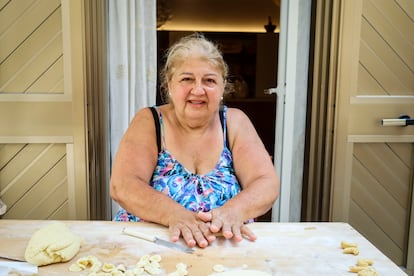Bari’s guardians of pasta: Preserving an ancient art
A group of grandmothers in southern Italy prepare kilos of orecchiette on their doorsteps. Thanks to tourists, they have gone viral on social media


Every morning at 10 a.m., come rain or shine, summer or winter, the women of Arco Basso take their tables out to the street. On the spianatoia — the wooden slab used for making pasta — they begin to work. They make a small volcano with a handful of semolina, add streams of warm water and knead with all their strength, until the mixture becomes a ball of yellow dough. Then the real spectacle begins: transforming the compound into hundreds of thousands of orecchiette, the ear-shaped pasta with over a thousand years of history in southern Italy.
The location is Bari, the capital of Apulia, the region known as the heel of the boot. They are Nunzia, Angel and Rosa, the guardians of the tradition of fresh pasta. They have dedicated their lives to the art. They learned to make pasta before they learned to read or write. Every day they return to the trade, which has required many sacrifices; “My grandmother taught me when I was five years old. Before going to school, I had to help her to put out the boards and prepare the dough,” says Angela Lastella, who is now 68 years old. With chestnut hair and a freckled face, she wields a blue-handled knife with a wide blade, slicing through the cords of dough that become tiny ears. She serrates a piece, drags it across the board to create a cavatelli and turns it with her thumb to create the pasta’s concave shape
When tourists begin to arrive in mid-morning, the grandmothers have several kilos of pasta ready to sell. “All my life I’ve gotten up early. First I have to clean the house and do the shopping. I make lunch before starting to sell pasta, because at 1 p.m. the men return to eat, and everything has to be ready,” says 62-year-old Rosa Lastella, as she sells two kilos of orecchiette to a young vacationing couple.
The pasta comes in three sizes: small, large and giant, the famous orecchione, or big ear. The semolina gives it its classic yellow color, but there is also brown orecchiette, with whole-wheat semolina, or red and green, with tomato and spinach, respectively.
In the last few years, it has become the city’s most prized souvenir. Now, not a day goes by without groups of foreigners, fresh off of the cruise ships docked in the port, passing through the alleyway of the historic district. “Two fifty,” the women repeat in stilted English to the tourists who want to purchase a half-kilo bag.
@guigurui This famous street of Bari will make you hungry seeing how they make fresh pasta all day long 😍 Esta famosa calle de Bari te dará hambre viendo cómo elaboran pasta fresca durante todo el día. #Orecchiette #Guigurui 📍Strada Arco Basso, #Bari #pasta #Puglia #italia #italysegreta #howitalyfeels #italy #europe #superitaly #foryou #fy #booktok
♬ Che La Luna - Louis Prima with Sam Butera & The Witnesses
Seeing the women in their homes, as they knead and share neighborhood gossip, is part of the experience. Curious visitors come to the Arco Basso after having seen the viral videos of 65-year-old Nunzia Caputo. Her home is the Mecca of orecchiette lovers, the ground zero where everything began, and she is the protagonist that everyone wants to meet. Her house even appears on Google Maps: “Nunzia Pasta Lady extraordinaire of Bari Vecchia.” “My mother isn’t home right now, come back later,” her son Rino tells someone who wants to take a photo with her. In her absence, he stays behind with the bags for sale and the boards where the freshly made pasta dries.
From the street to the table
Before tourists reached the narrow, mysterious streets of Bari vecchia, the women of Arco Basso had spent their lives producing kilos and kilos of orecchiette for the kitchens of the city’s restaurants. Despite being a very simple pasta, made with just two ingredients — flour and water — or perhaps because of that, its uses in the kitchen are quite varied. The pasta appears on menus at all the restaurants in Bari and the wider province.
Its most popular version is paired with bitter-tasting cime di rape, or broccoli rabe. The vegetable is cooked in boiling water with the pasta, which is later sautéed with oil and a few cloves of garlic. “Some people also add a few peppers to give it a spicy touch, but the best is to add pickled anchovies,” Angela suggests. She finishes off the dish with a pinch of breadcrumbs toasted in olive oil, known as “poor man’s cheese.” Despite being the city’s star dish, it can only be prepared in autumn and winter, during broccoli rabe season. The rest of the year, it is paired with a tomato and ricotta sauce or, on Sundays, ragu with braciole — meat rolls stuffed with parmesan, garlic and bacon.
When Nunzia finally arrives, all the attention is on her. With one hand, she eats taralli — mini bread rolls — and with the other, she begins to make pasta. Within seconds, bystanders surround her table, hypnotized by her skill with the knife. Just like the rest, Nunzia began learning the art when she was young. “Making the pasta isn’t complicated,” she says as she begins the third mixture of the morning. “It’s like any other job. To do it well, you have to love it.” And she loves pasta, despite the fact that her mother forced her to leave school to help at home. “I love it because it’s the most valuable thing that my family left me. It isn’t just about making food. My mother passed the tradition down to me, and I pass it on to other generations.”
The people of Bari know that Nunzia opens her home to whoever wants to eat a freshly made plate of orecchiette at lunch time. At night, the menu also includes panzerotti, focaccia and other regional specialties. Tourists also end up finding out about the open secret, and they arrive at all hours of the day seeking a plate of pasta, like two American girls who ask for lunch at eleven in the morning. Rino, Nunzia’s son, attends their requests: he prepares the tables, answers the phone for reservations and charges diners at the end of the meal (the price ranges from $10 to $20 depending on the quantity and variety of the meal).
He is one of the few men working on the street. The rest —the husbands, sons and brothers of the pasta women — spend the day with a bottle of beer in hand in the bar at the end of the alley, under the arch that gives the passageway its name. Despite the influx of tourists in the neighborhood, many families in the area still live on the brink of poverty. The homes are small and dark, the native language is the barese dialect and the school dropout rate is one of the highest in the city. The women themselves stopped studying after elementary school. “I was really good at math. I know the multiplication tables better than all my siblings,” recalls Rosa.
“And why did you leave school?”
“I had to help make pasta at home.”
“Do you regret it?”
“Not at all. We keep history alive.”
Sign up for our weekly newsletter to get more English-language news coverage from EL PAÍS USA Edition
Tu suscripción se está usando en otro dispositivo
¿Quieres añadir otro usuario a tu suscripción?
Si continúas leyendo en este dispositivo, no se podrá leer en el otro.
FlechaTu suscripción se está usando en otro dispositivo y solo puedes acceder a EL PAÍS desde un dispositivo a la vez.
Si quieres compartir tu cuenta, cambia tu suscripción a la modalidad Premium, así podrás añadir otro usuario. Cada uno accederá con su propia cuenta de email, lo que os permitirá personalizar vuestra experiencia en EL PAÍS.
¿Tienes una suscripción de empresa? Accede aquí para contratar más cuentas.
En el caso de no saber quién está usando tu cuenta, te recomendamos cambiar tu contraseña aquí.
Si decides continuar compartiendo tu cuenta, este mensaje se mostrará en tu dispositivo y en el de la otra persona que está usando tu cuenta de forma indefinida, afectando a tu experiencia de lectura. Puedes consultar aquí los términos y condiciones de la suscripción digital.
More information
Archived In
Últimas noticias
Most viewed
- Sinaloa Cartel war is taking its toll on Los Chapitos
- Oona Chaplin: ‘I told James Cameron that I was living in a treehouse and starting a permaculture project with a friend’
- Reinhard Genzel, Nobel laureate in physics: ‘One-minute videos will never give you the truth’
- Why the price of coffee has skyrocketed: from Brazilian plantations to specialty coffee houses
- Silver prices are going crazy: This is what’s fueling the rally










































